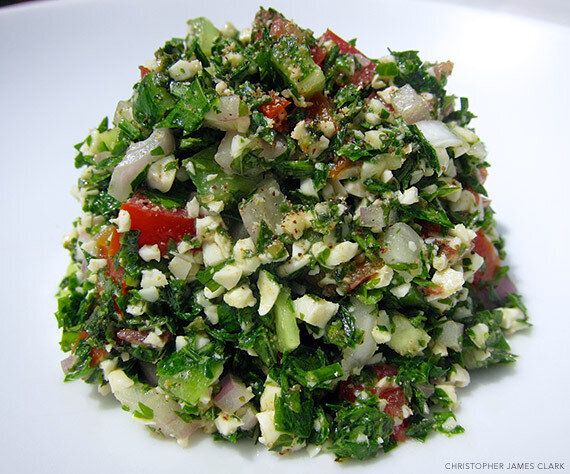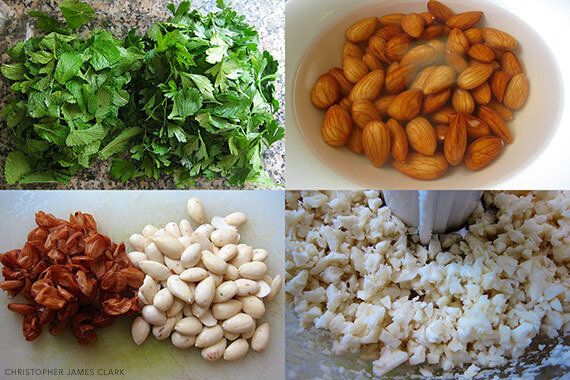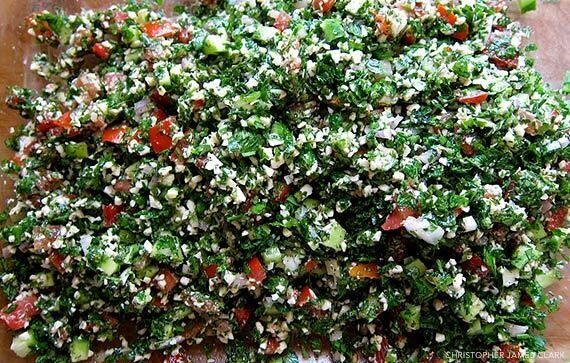
From a nutritional perspective, some traditional recipes are perfect just the way they are; others need tweaking. Tabbouleh, a traditional Middle Eastern dish, offers dense nutrition and bold, delicious flavors. For the millions of people avoiding wheat, however, tabbouleh's inclusion of bulgur spoils the fun. Omitting the bulgur is an option, but swapping in germinated almonds is far more interesting. We'll get to the recipe, but first let's briefly give wheat the benefit of the doubt.
Wheat, a staple food for thousands of years, has recently come under scrutiny because it contains gluten. Roughly 30 percent of US consumers are choosing gluten-free products and analysts expect the booming gluten-free market to eclipse $15 billion by 2016, a 50 percent increase compared to 2013. Gluten fears are understandable, but perhaps not warranted.
Celiac disease is four times more common today than it was 60 years ago, affecting roughly one person per 100. In the US, the National Foundation for Celiac Awareness estimates that 3 million people have the disease and another 18 million have non-celiac gluten sensitivity (NCGS). Additionally, upwards of 20 percent of Americans have irritable bowel syndrome (IBS), a condition that gluten can aggravate. Not everyone, however, is convinced that gluten is causing all our gastrointestinal woes.
Recent research suggests that FODMAPs, not gluten, might be responsible for increasing NCGS and IBS prevalence. FODMAPs, an acronym for Fermentable, Oligo-, Di-, Mono-saccharides And Polyols, are short-chain carbohydrates, which digest incompletely, causing digestive distress for some people. FODMAP foods include those containing fructose (sugar, honey, fruit), lactose (dairy), fructans (wheat, onion, garlic), galactans (legumes), and polyols (sweeteners containing sorbitol, mannitol, xylitol, and stone fruits such as avocados, apricots, and cherries).
Wheat is a high FODMAP food, which might explain why some people diagnosed as gluten-sensitive feel much better when avoiding wheat. The science behind gluten, FODMAPs, NCGS, and IBS is far from settled. Gluten might be off the hook, except for celiac patients, for whom it triggers severe autoimmune reactions, but the wheat industry shouldn't be raising champagne glasses.
Many people astutely ask how wheat, once considered healthy, suddenly became a menace. One reason is fermentation. The FDA defines "gluten-free" as products containing 20 parts per million (ppm) or less of gluten. Lacto-fermentation—the kitchen chemistry behind traditional, sourdough bread—significantly decreases gluten, as low as 12 ppm, while making wheat's nutrients more bioavailable.
In other words, food processing can significantly change food quality, for better or worse. Traditional processing typically improves nutrition, but most people aren't consuming traditionally processed bread. At the turn of the 20th century, 90 percent of bread was homemade, but today 90 percent is commercially processed, which implies no fermentation and the inclusion of wheat derivatives such as deamidated gluten (DG).
The damaged intestinal cells of celiac patients release an enzyme called tissue transglutaminase (tTG), which converts gluten into DG, a highly immunoreactive compound. Even people who don't have celiac disease, when exposed to DG, can have serious reactions. But how would they be exposed, assuming their intestinal cells are not damaged? The answer is processed wheat.
Manufacturers intentionally add DG to mass-produced baked goods because it improves their textures. A 2008 study published in the European Journal of Inflammation observed, "This extensive use of wheat isolates in the food industry may be the major cause of hidden food allergies...Because food isolates or deamidated gluten are new food ingredients, when allergy to wheat is suspected, immune reaction to wheat isolates should be tested."
So wheat definitely has some issues, including several potentially problematic components (gluten, FODMAPs, wheat germ agglutinin), as well as food processing problems (abandoning fermentation, DG). Moreover, wheat is high in carbohydrates. Carbs aren't bad—every healthy diet should include some—but when consumed excessively they can promote disease and distress.
Just last week, scientific advisors to the British government proposed new maximum daily sugar intake recommendations of 25 grams for women and 35 grams for men. These recommendations are progressive, but cutting back on sugar requires more than just willpower. Reducing sugar cravings requires identifying the sources of these cravings, which can include carbs elsewhere in the diet. Studies consistently demonstrate that low-carb diets more effectively promote weight loss compared to low-fat diets, suggesting low-carb meals are more satiating, whereas high-carb meals tend to induce cravings, especially for sugar.
Personally, I rarely eat wheat, but I'm not calling for its prohibition. I think we should be more intelligent about wheat, embracing traditional sourdough processing while reducing the quantity we consume. With this in mind, traditional recipes should sometimes be reimagined. Recipes are like language and culture. They should be flexible and dynamic, changing in accordance with modern knowledge and perspectives. Here's an idea for tabbouleh, minus the wheat.
Almond Tabbouleh
- 1 handful soaked almonds
- 1 bundle fresh mint
- 2 bundles fresh parsley
- ½ purple onion (omit for reduced FODMAPs)
- 2 medium tomatoes
- 2 small cucumbers, peeled
- ¼ cup olive oil
- 2 tablespoons lemon juice
- Freshly milled black pepper
Directions
- The almonds should be soaked 8 hours or overnight; discard the soaking water.
- To remove their skins, boil some water and submerge the pre-soaked almonds for about 30 seconds. Transfer to cold water. Rub the almonds between your fingers; the skins should slide off easily.
- Transfer the peeled almonds to a food processor and grind to a coarse texture resembling cooked bulgur.



SERVES 3-4
________
Christopher James Clark is the author of the critically acclaimed book, Nutritional Grail: Ancestral Wisdom, Breakthrough Science, and the Dawning Nutritional Renaissance